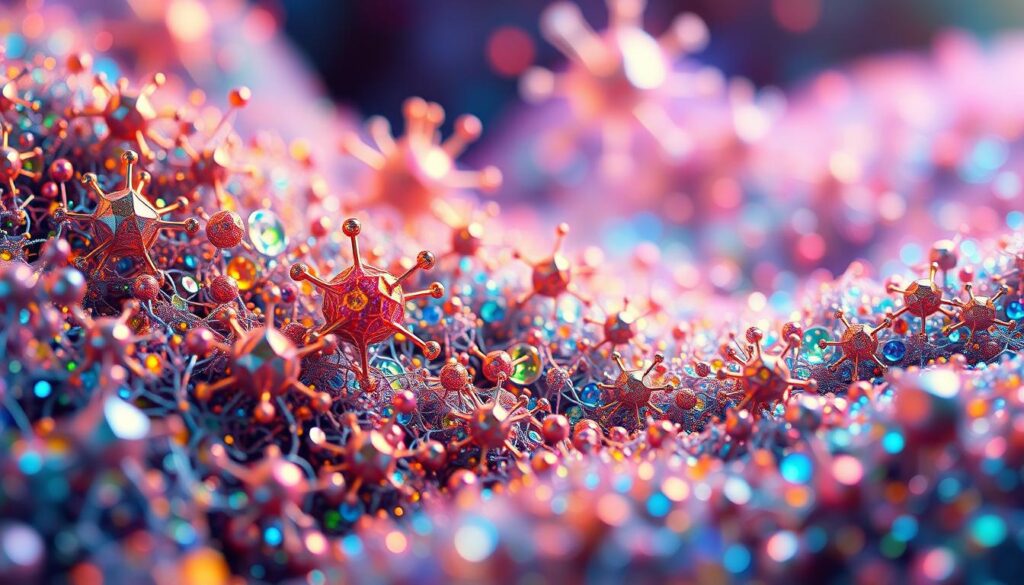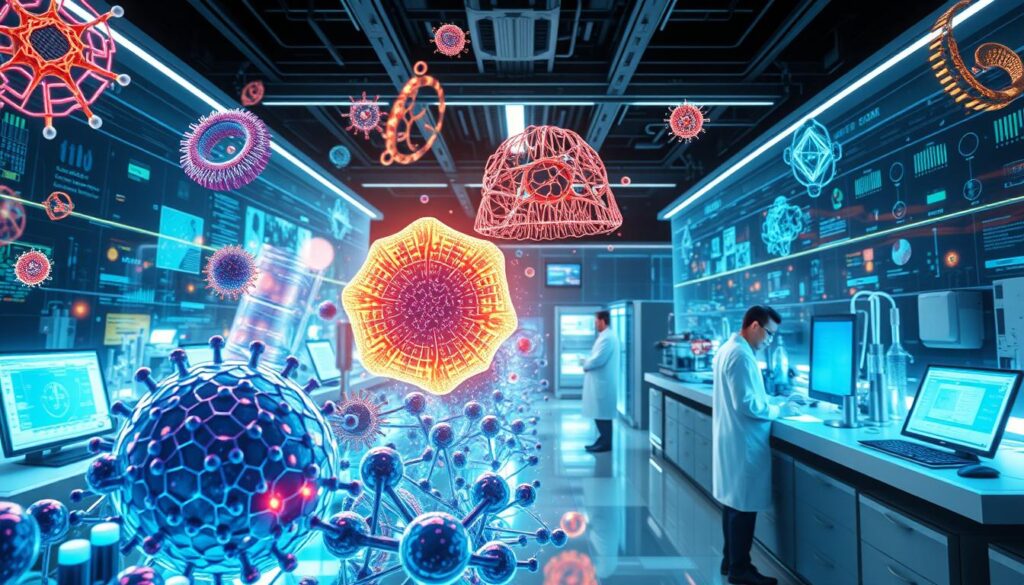Physical Address
304 North Cardinal St.
Dorchester Center, MA 02124
Physical Address
304 North Cardinal St.
Dorchester Center, MA 02124

Nanotechnology, or nanotech, is a field that’s growing fast. It’s all about working with tiny things, smaller than what we can see. This field could change many areas, like medicine and electronics, and big companies like IBM and Google are already working on it.
Exploring nanotechnology opens up a world of possibilities. It could lead to new materials and treatments in medicine. This field is always changing, thanks to nanoscience, and it’s being used in more and more ways.

Nanotechnology is a complex but exciting field that could change our lives. As we learn more about it, we see how important nanoscience is. This field is growing, and its effects will be seen for a long time.
Nanotechnology has become very popular lately. It involves working with matter on a very small scale, between 1-100 nanometers. This field has created new nanomaterials with special properties. These materials are being used in nanomedicine and nanoengineering.
To get the basics of nanotechnology, we need to understand its core principles. The nanoscale is a unique area where physics works differently than at larger scales. Knowing these differences is key to creating new technologies. Important concepts include the properties of nanoparticles and how materials behave at the nanoscale.
The nanoscale is between 1-100 nanometers. At this size, materials have different properties than they do in bulk. They have a high surface area to volume ratio, making them more reactive and conductive. Nanoengineering uses this scale to create new nanomaterials for use in nanomedicine and other areas.
The idea of nanotechnology has been around for decades. But, recent years have seen big leaps forward. New tools like atomic force microscopy have allowed scientists to study and work with materials at the nanoscale. This has helped us understand nanomaterials better and their uses in nanomedicine and nanoengineering.
| Field | Application |
|---|---|
| Nanomedicine | Drug delivery, cancer treatment |
| Nanoengineering | Development of new materials, devices |
| Nanomaterials | Energy storage, electronics |
Nanotechnology deals with tiny matter, usually measured in nanometers. It uses nanorobotics and nanoelectronics to create small robots and electronic devices.
Key components of nanotechnology include:
The field of nanotechnology is growing fast. New discoveries and innovations keep coming. We’ll see more exciting uses of
Thanks to nanorobotics and nanoelectronics, scientists make devices that work at the nanoscale. This leads to new solutions for many problems. As nanotechnology grows, we’ll see even more amazing things.
Nanotechnology has brought about new materials with special properties. These materials are changing many industries. Nanomaterials are stronger, more conductive, and better at handling light. Nanoengineering helps make these materials, which are now used in many fields, like energy and medicine.
The field of nanotech has made big strides. New materials like carbon nanotubes, quantum dots, and nanostructures are being developed. These could change industries like energy, medicine, and electronics. For example, carbon nanotubes make materials strong and light, while quantum dots improve solar cells.
Carbon nanotubes are getting a lot of attention. They are very strong, conduct heat and electricity well, and are great for many uses. They’re good for energy storage, making materials stronger, and in electronics.
Quantum dots are tiny crystals that could change many industries. They help make solar cells, LEDs, and other devices work better. Smart materials can change based on their surroundings. They could be used in medicine, sensors, and more.
Nanomedicine is a fast-growing field that has made big strides in medicine. It uses nanotechnology to create new treatments and tools. One exciting area is targeted therapies, which use nanorobotics to send medicine to specific cells.
Some key uses of nanomedicine include:
As nanomedicine research grows, we’ll see more new treatments and technologies. Nanotechnology is changing healthcare and is very promising for the future.
Researchers are using nanotechnology and nanorobotics to make personalized medicine. This could lead to better treatments and fewer side effects. It’s a promising area in nanomedicine.
| Application | Description |
|---|---|
| Targeted cancer treatments | Using nanorobotics to deliver medication directly to cancer cells |
| Diagnostic tools | Developing tools for early disease detection using nanotechnology |
| Implantable devices | Creating devices for regenerative medicine using nanomedicine |
Nanoelectronics has changed how we compute and communicate. It uses nanotechnology to make devices smaller, faster, and more efficient. This has led to new tech like quantum computing, which can solve problems that old computers can’t.
The effects of nanoelectronics are huge. For example, nanoscale transistors have made devices like smartphones and laptops smaller and more powerful. Also, nanotechnology has made devices that use less energy, which helps the environment.
Quantum computing is a big deal in nanoelectronics. It uses quantum mechanics to solve problems that old computers can’t. This could change fields like medicine, finance, and climate modeling.
Nanoelectronics is also changing next-generation electronics. It helps make devices smaller, faster, and more efficient. This has led to new tech like Internet of Things (IoT) devices, which are changing how we live and work.
Some key benefits of nanoelectronics include:
Nanoelectronics is also making devices that use less energy. This has led to new tech like smart grids and renewable energy systems. These are changing how we make and use energy.
Nanotechnology can help solve big environmental problems like climate change and water scarcity. It uses green technologies, cleans pollution, and boosts sustainable energy. This makes nanotechnology key for a greener future.
Nanomaterials in environmental uses are showing great promise. Nanoengineering helps make these systems more effective.
Some key areas where nanotechnology can help include:

The field of nanotechnology in environmental sustainability is growing fast. New discoveries and innovations keep coming. As research gets better, nanotechnology will play a bigger role in solving environmental problems.
Nanotechnology has the potential to revolutionize environmental sustainability. It’s crucial we keep investing in research and development to unlock its full potential.
| Application | Description |
|---|---|
| Water treatment | Removal of pollutants and contaminants from water using nanomaterials |
| Air purification | Creation of more efficient air purification systems using nanoengineering |
| Sustainable energy | Creation of more efficient solar cells and energy storage systems using nanotechnology |
Nanotechnology has seen great progress, but it still faces many challenges. One big worry is the safety of nanomaterials. They could harm humans and the environment. It’s vital for researchers to study these risks and find ways to reduce them.
Some major hurdles in nanotechnology include:
The field of nanoscience is growing fast. It’s important to tackle these challenges to ensure nanotechnology is developed responsibly. This way, we can use nanotech to create new solutions that help society and the environment.
As we move forward in nanotechnology, teamwork, research, and development are key. They help us overcome current obstacles and look towards a brighter future for nanotech.
| Challenge | Description |
|---|---|
| Safety concerns | Assessing the potential risks of nanomaterials and developing strategies to minimize them. |
| Technical limitations | Overcoming the technical hurdles that hinder the widespread adoption of nanotechnology. |
| Regulatory framework | Establishing a clear and comprehensive regulatory framework to govern the development and use of nanotechnology. |
Nanotechnology is set to change many industries, like energy and healthcare. It could change how we live and work. New nanomaterials and nanoengineering methods will be key in this change. As research goes on, we’ll see big steps forward.
New trends in nanotechnology include using nanomaterials for green energy like solar and fuel cells. Nanoengineering is also making new medical tools, like nanorobots and biosensors. This could greatly improve healthcare, from better drug delivery to tailored treatments.

Nanotechnology is set to change many areas of life. With more research, we’ll see new breakthroughs. These will lead to more uses of nanotechnology, nanomaterials, and nanoengineering.
| Area of Focus | Potential Applications |
|---|---|
| Nanomaterials | Sustainable energy solutions, medical devices, and implants |
| Nanoengineering | Medical devices, implants, and targeted drug delivery |
| Integration with other fields | Artificial intelligence, biotechnology, and personalized medicine |
The nanoscale world is full of amazing possibilities. It shows us how nanotechnology and nanoscience can change our lives. These fields are making new discoveries that are truly groundbreaking.
Things like carbon nanotubes and quantum dots are creating new materials and smart technologies. They are changing many areas, from medicine to energy and the environment. These tiny wonders are making big impacts.
The future of the nanoscale world looks even more exciting. We can expect big changes in things like quantum computing and new electronics. Nanotechnology will keep pushing what’s possible and changing our lives in amazing ways.
Exploring nanotechnology has been an incredible journey. It’s filled with discoveries that promise a better future. As we end this journey, we’re left feeling inspired by the power of the nanoscale world and its potential for humanity.
Nanotechnology is the study and use of materials at the nanoscale, from 1 to 100 nanometers. It involves working at the molecular and atomic levels. This leads to the creation of new materials and devices with special properties.
Nanotechnology has many uses in fields like medicine, energy, and electronics. It can improve drug delivery, energy storage, and electronics performance. It also helps in making new materials and cleaning the environment.
At the nanoscale, materials show unique properties not seen at larger scales. These properties come from quantum effects and the material’s surface. This makes nanomaterials and devices more powerful and functional.
Developing nanotechnology faces challenges like ensuring safety and addressing environmental impacts. There are also technical hurdles in making and using nanostructures. Researchers work hard to overcome these to fully use nanotechnology.
Nanotechnology could greatly benefit society and the economy. It could improve healthcare, energy, and materials science. This could make life better, increase efficiency, and boost the economy. But, there are also ethical and social concerns that need careful thought and rules.
Nanotechnology is changing medicine with nanomedicine. It’s used for targeted drug delivery, early disease detection, and personalized treatments. It also helps in creating advanced prosthetics and implants.
Nanotechnology has environmental benefits like more efficient energy systems and water purification. It also helps in making products and processes that are better for the environment. This reduces waste and conserves resources.